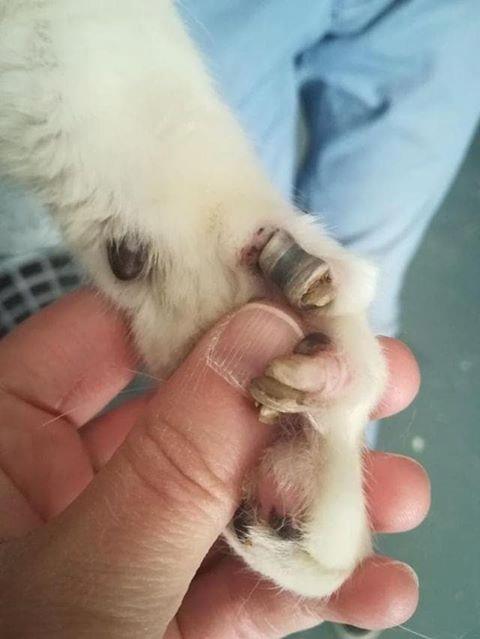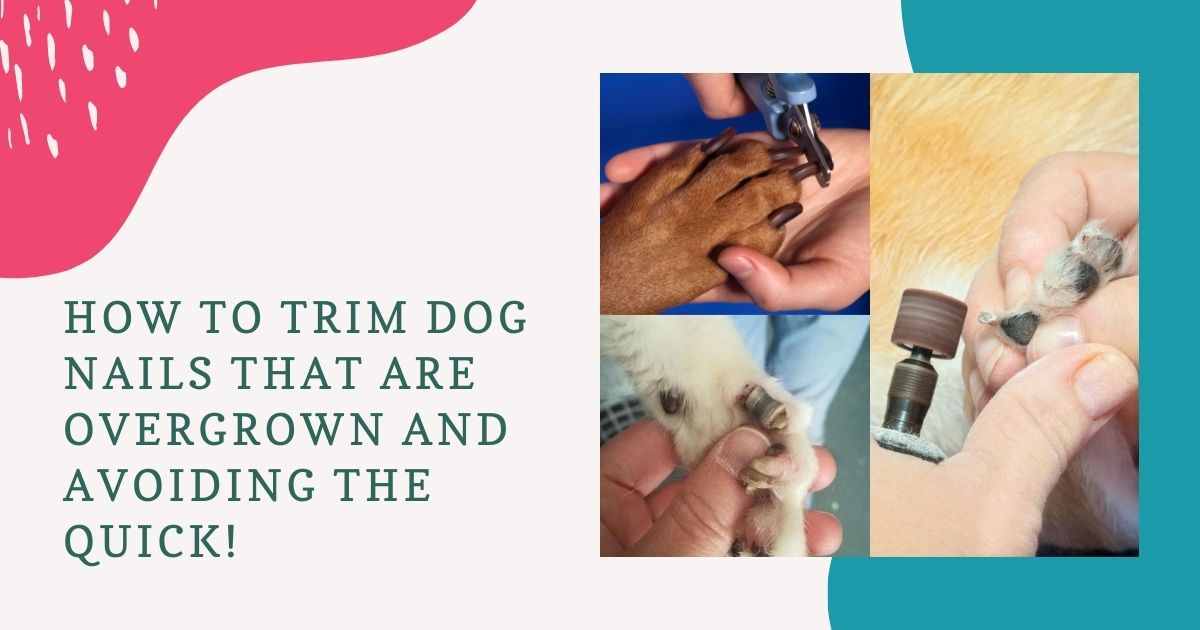How Often Should I Trim my Dog’s Nails?
Owners often have difficulty knowing how to trim dog nails that are overgrown, which can lead to their dog being in discomfort or having excessive vet visits just to trim their nails. The frequency in which your dog’s nails need to be trimmed will vary from case to case and is dependant on age, breed, and activity level.
Some breeds of dogs will have naturally longer quicks and longer nails, requiring more frequent trimming of the nails every few weeks or monthly. On the other hand, very active dogs, especially those walked on concrete, will wear down their nails naturally and may not require nails trims or will require them very sparingly. And, of course, older dogs that are not as active anymore will need regular nail trims, possibly weekly.

How Long Should Dogs Nails be?
The length of a dog’s nails should generally be just a bit longer than the quick (the pink flesh inside of the nail). However, dogs may have very long quicks in some cases, especially if their nails are overgrown, as the quick will grow with them. In these cases, it is important to regularly trim small amounts off the nails (once weekly should be sufficient) to prompt the quick to retreat to a standard length.
Signs of nails being too long can include splaying of the feet due to the excessive nail length, tapping sounds when walking, discomfort walking, and discomfort in bearing weight on their limbs in general.
What Can Happen if I Don’t Trim my Dog’s Nails?
If a dog’s nails are left untrimmed, they can cause discomfort and health issues. Again, some dogs may not need nail trims or very infrequently require them due to their age and active lifestyle, so keep an eye on the length of your dog’s nails and trim as needed for their lifestyle.
Why are Long Dog Nails a Problem?
Overgrown nails can keep growing into the paw pad, putting pressure on the pads and sometimes even piercing the skin. This can cause your pet physical pain and may discourage them from walking or bearing weight on their paws.
In some cases, long untrimmed nails may cause the paw pads to splay out and cause an uneven weight distribution. This can lead to more severe problems such as tendon injuries or deformed paws but generally will mainly cause discomfort when weight bearing on the limbs.
Long dog nails can also be a safety hazard, making it easier to get them caught on things around the home and increasing the risk of pulling their nail out of the bed. This is a very painful injury and could result in an emergency visit to your vets!
What to do if Your Dog Hates Nail Trims
The chances are, unfortunately, relatively high that your dog will not love having their nails trimmed. As a result, many owners choose to have their dog’s nails trimmed by a veterinarian or professional dog groomer rather than going through the traumatic ordeal themselves. But for those of you who want to train your dog to tolerate nail trims at home, we have a few tips.
The best approach for training your dog to lose their fear and anxiety associated with nail trimming is to go slow and use plenty of positive reinforcement to create a positive experience for them.
In extreme circumstances, it may be safest to allow a veterinary professional to handle trimming your dog’s nails if you think it causes them too much anxiety or if you are concerned about them physically harming you or others assisting you.
Our Top Tips to Make Dogs Nail Trimming Tolerable
Slow and steady wins the race!
Gradually introduce the nail clippers to your pet by allowing them to sniff them and giving them treats when they are exposed to them. Do not attempt to trim the nails if your dog is still frightened by the sight of the clippers; just wait until their fear subsides and they associate seeing the nail clippers as a positive experience.
Some pets with fear of having their paws touched at all may require an initial step of touching their paws and giving them treats until they no longer fear the touch.
Have a trusted assistant
As a general rule, it will be safer for you and your pet if you have someone to hold and comfort your dog while you trim the nails. This will help reduce their anxiety, especially if the person holding them is someone they know and trust.
A proper holding technique reduces the risk of injuring your pet if they move their paw and you cut the quick, and the risk of the pet becoming increasingly anxious and causing harm to the nail trimmer.
You can never have enough treats!
Training out bad behavior and anxiety can require a lot of treat-based motivation. Ensure you are using a good quality treat for your pet, and if you are using a lot of treats, consider their overall calories in the day and maybe reduce their lunch or dinner to accommodate the extra food.
Learn the length of your dog’s quicks
One of the biggest reasons a dog can develop fear or anxiety of having their nails trimmed is because they had a bad experience in a previous nail trim where the quick was cut and started bleeding.
Finding the quick is easier in dogs with clear or white nails, as you can clearly see where the pink starts. For those with black nails, it can be a more difficult process. Often you will need to see the bottom of the nail and where the texture changes from the pointy end of the nails to the solid underside of the nail in which the quick will be hidden.
Be patient
Try to remain calm, always give plenty of love, and allow your dog as much time as they need to get used to the process. Once they are used to having their nails trimmed, you won’t have to fight with them anymore, and the experience will be less stressful for you and your pet.
If you do clip the quick
As much as we try to avoid this, clipping the quick can occur when trimming nails. Try to remain calm and stop the bleeding with a styptic powder or silver nitrate stick (essential for every owner to have when considering cutting their dog’s nails).
Give your dog plenty of praise and love for being brave, and consider taking a break before trimming the rest of the nails or coming back to try again another day.
A Step-by-Step Tutorial on Trimming Overgrown Dog Nails
Youtube tutorials can be a helpful visual aid for owners becoming familiar with trimming overgrown dog nails. Here are some step-by-step instructions for trimming your dog’s nails!
Step 1: Introduce the nail clippers
Provide treats and introduce the nail clippers to your pet before the nail trim begins. Also, start touching their feet and holding the nail clippers up to their feet before you begin the actual trimming of the nails.
Step 2: Ensure you are holding in a safe manner
Ideally, have an assistant with you to hold your dog safely while you are going to trim the nails. Ensure they are holding the dog with their head away from you, supporting their body, and holding out the paw for you to cut the nails safely.
Step 3: Identify the length of the quicks
Once your dog is comfortable around the clippers, grab their paw and start examining the nails themselves. If your dog has white or clear nails, look for the pink flesh inside the nail, and know not to cut any shorter than that.
We need to be a bit more careful with dogs with black nails, generally trimming much smaller areas until we can see the gray-pink oval appear at the top of the cut surface. This will indicate you are closer to the quick, and if you see a small black dot in the center of the white portion, this means you are too close to the quick and should stop cutting.
Step 4: Begin the trim.
When beginning to trim the nails, it is essential to cut tiny bits of the nail at a time, but do so quickly and confidently. Hesitation and nerves with an owner can cause stress for your pet too, so ensure you feel comfortable when trimming the nails.
To ensure you are not cutting them too short, it is always best to trim small amounts until you reach the desired length. Also, ensure you are cutting the nails at an angle that suits their natural nail shape. Accidents can also occur when cutting the nails too fast, so take your time to feel confident.
Step 5: Ensure plenty of positive reinforcement throughout the procedure.
Ensure that you or your assistant provide plenty of positive reinforcement to ensure your pet that this is a positive experience. This can be giving pats, cuddles, talking to them, and giving treats. For example, some dogs will happily let you trim their nails while they lick some peanut butter or wet food out of a bowl held in front of them.
Step 6: Repeat as needed.
Keep an eye on the length of your dog’s nails and how they grow. Keep up the nail trimming regularly so that they do not become overgrown. The more overgrown a dog’s nail is, the more discomfort it will cause them, making trimming the nails more difficult. It is best to keep this as part of a regular routine.
Summary
For us humans, it may seem silly that our dogs are so fearful of a simple nail trim, but actually, the process of trimming nails can cause severe stress and anxiety for your beloved pet. Therefore, pet owners who want to clip their pet’s nails at home must create a safe and positive environment for your pet to help reduce their anxiety.
Once they feel safe and comfortable with you, and you yourself feel comfortable trimming the nails safely and confidently, those days of fighting your pet to give them a mani-pedi will just be a memory.


3 thoughts on “How to Trim Dog Nails That Are Overgrown And Avoiding the QUICK!”
Comments are closed.